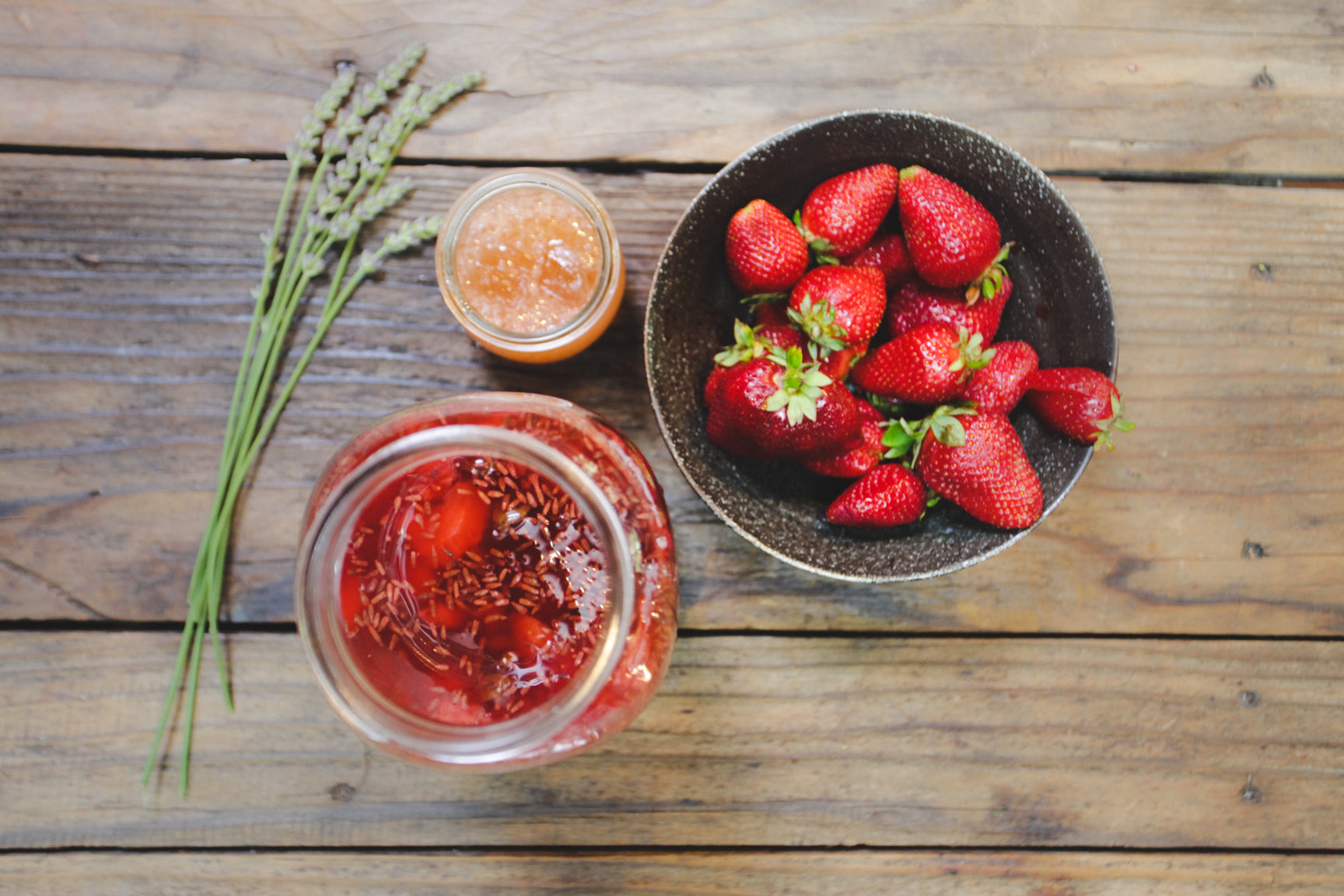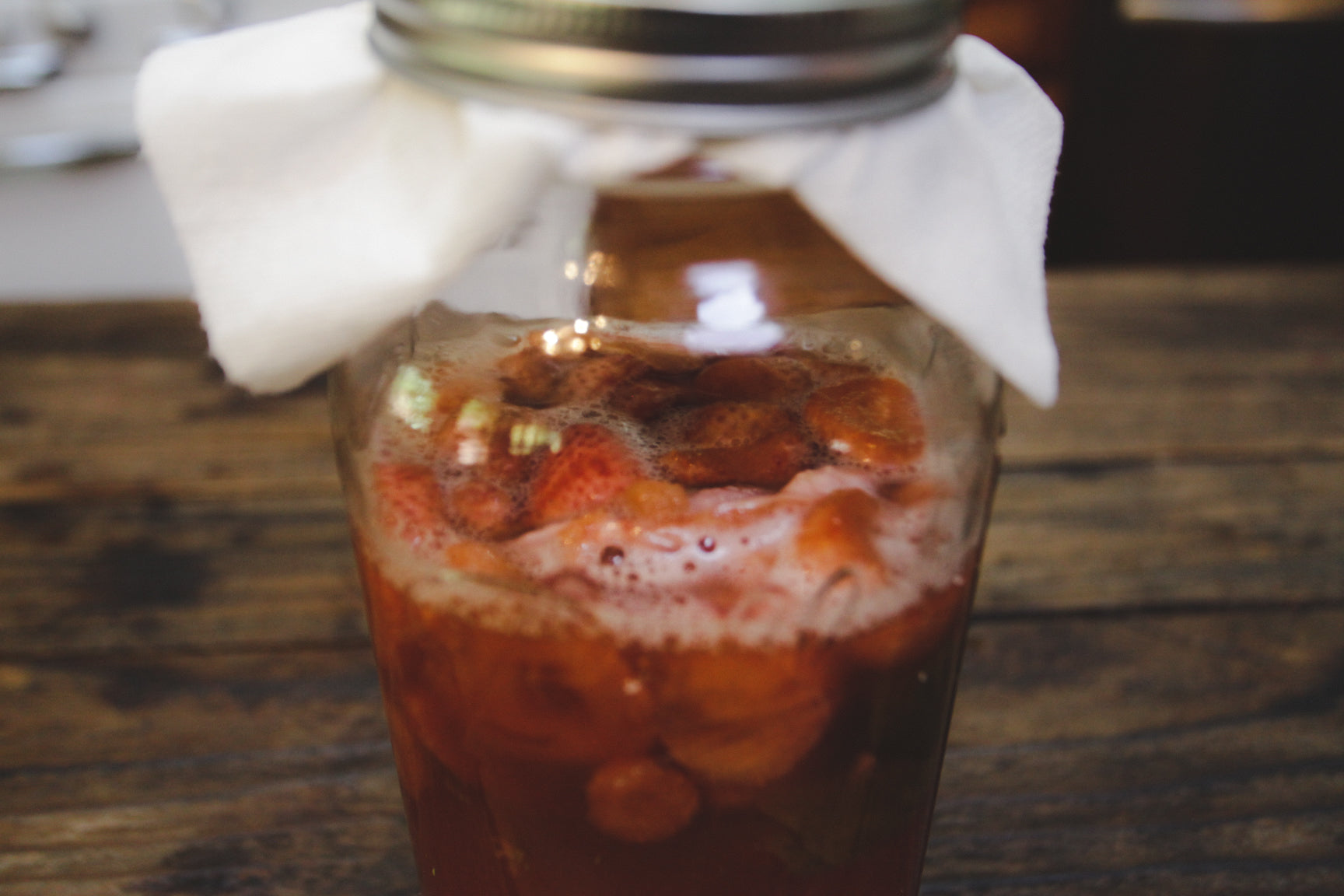- Continue Shopping
- Your Cart is Empty
2 Shrub Recipes: a Sour Sparkling Sip

What You'll Need
Equipment
- 1/2 Gallon Mason Jar or large clamp top jar
- Measuring cups (liquid and dry)
- Funnels (useful, but not required)
- Saucepan
- Food thermometer
- Fine cheesecloth or mesh strainer
Ingredients for Strawberry Basil Shrub
- 1 1/2 cups of distilled white vinegar or vinegar labeled at least 5% acidity
- 1 basket of strawberries (about 2 cups), chopped, with the tops cut off
- Half a bunch of fresh basil, chopped, stems and all
Ingredients for Strawberry Lavender Shrub
- 1 cup red wine vinegar
- 1/2 cup balsamic vinegar
- tops and bruised parts of 1 basket of strawberries…or use the whole berry, of course, if you like, chopped.
- 1 TBS dried lavender flowers
I invented the shrub. Well, technically, that is untrue.
What I mean is, that I came to the idea of drinking vinegar all on my own, moved by a particularly glorious batch of homemade quince vinegar. On a whim, I poured a shot of the ambrosial vinegar into some Prosecco. Voila! Instant cocktail. And so the shrub was born.
Imagine my surprise when I found out that drinking vinegar was, indeed, A Thing. Already on the internet, already available on the drink lists of swanky cocktail bars... already hip. Sigh.
Well, if I could not lay claim to the next big thing, I could at least investigate it further. My first opportunity came at the Farmers' Market, when I scored a flat of 'jam berries' for $10. Scarlet, plump, perfectly ripe, and just a little worn, these berries seemed like the perfect place to begin experimenting. A bunch of early green basil came home with me that day too, and I set about the making of an official shrub.
What is a Shrub?

Basically, a shrub is a fruity, flavored vinegar, which is often sweetened and cooked down into a syrup, commonly used to flavor cocktails or carbonated drinks.
An ancient beverage, it can also be used to preserve fruits with the water bath canning method, assuming that the pH is acidic enough. While the very first shrubs were likely fermented directly from the fruits themselves, it is more common these days to use pre-made vinegar as a base into which the fruit flavors can be infused.
Different Shrub Techniques and Recipes Abound
The internet being what it is, recipes abound for shrubs of all sorts.
Some recommend the addition of sugar to the primary infusion, while others save the sweetener until later. Some chop the fruit and mix it with sugar, and then strain that mixture and add vinegar.
There’s no wrong way to do it, really, but here are a few strawberry-based recipes, to get the inspiration flowing.
A Few Notes on Flavoring Shrub
I chose not to cook either of these down after straining the fruit out, so they were essentially just fruit vinegars, and not the thicker, sweeter syrups that are also known as shrubs.
This made it easy to add to sweeter beverages like unflavored water kefir, or fruit juice mixed with sparkling water. Or champagne, or prosecco, or...well, you get the idea.
When mixing it with alcoholic beverages, I found a bit of maple syrup helped sweeten and balance the sharp vinegar bite, but if you intend to use it primarily as a mixer for alcoholic cocktails, I would recommend adding the sugar and cooking it down into syrup.
However you choose to use it, a splash of shrub enlivens everything it touches.
Directions for Strawberry Basil Shrub
1) Heat the Vinegar
Heat the vinegar on the stovetop to just below the boiling point, or at least 190°F.
2) Combine your Ingredients
Put the chopped berries and basil in a half-gallon mason jar, and pour the hot vinegar over them. 
3) Steep your fruit
Allow the berries to float in the jar, covered, until they lose their color (about 2 weeks) By the end of this time, the vinegar will have become ruby red, and the berries will look as pale and colorless as vampires.
4) Strain and Store
Strain the berries and basil out through a metal or cheesecloth strainer into a clamp top bottle for storage.

5) Optional - Sweeten the Shrub
If you wish to turn the infused vinegar into a sweetened syrup, add as much as a pound of sugar per pint of juice. That’s a lot!
Feel free to add less, to taste. In order to dissolve this much sugar into the vinegar, it will be necessary to heat the strained vinegar and add the sugar, stirring as it cooks over low heat, until it is dissolved. Honey might also be used.
Directions for Strawberry Lavender Shrub
I looked at the pile of discarded strawberry tops from the first recipe, and thought of Sandor Katz’s excellent and adaptable fruit scrap vinegar recipe, which reminded me that even the discarded parts of fruit still contain so much fruit flavor.
So I gathered up all the strawberry tops, with their red fruit still clinging to the green leaves, and piled them into their own jar with some dried lavender flowers.
Just to try something different, I used a different combination of vinegars here.
1) Heat the Vinegar
Heat the vinegar on the stovetop to just below the boiling point, or at least 190°F.
2) Combine your Ingredients
Put the berries and lavender in a half-gallon jar, and pour the hot vinegar over them.
3) Steep
Allow the berries and flowers to steep in the jar for as long as it takes for them to loose their color, about 2 weeks. The dark color of the balsamic and red wine vinegars makes this more difficult to see.
4) Strain
Strain the solids through a cheesecloth or metal strainer into a clamp top bottle for storage.
5) Optional - Sweeten
If you wish to turn the infused vinegar into a sweetened syrup, add as much as a pound of sugar per pint of juice. That’s a lot! Feel free to add less, to taste.
In order to dissolve this much sugar into the vinegar, it will be necessary to heat the strained vinegar up and add the sugar, stirring as it cooks over low heat, until it is dissolved. Honey might also be used.
Storing your Shrub
Shrub can be stored in the refrigerator for up to 6 months. Discard if there are any signs of mold or off smells.
Over to You
It’s part of our mission here at Mountain Feed to help you make delicious, sustainable, homemade food more often. Stop by and say hello on Facebook, Twitter, Instagram or Pinterest. Or, as always, you can do it the old fashioned way and come by the store to speak with one of our in-house experts.
Keeping a great journal leads to delicious results! Get inspired by new recipes, expert articles and homemade food adventures in our Monthly Journal. This article was published as part of our August 2015 Journal: Vinegar and Heat.
